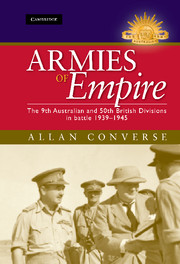2 - Playing at soldiers: 1919–40
Published online by Cambridge University Press: 05 August 2013
Summary
Both the 9th and the 50th were rooted in the long British tradition of amateur soldiering. Like the German Army, the British and Australian armies used a regionalised recruiting system that strengthened cohesion and morale. The 50th Division embraced the part-time volunteer TA units of Durham, Northumberland, and the North and East Ridings of Yorkshire, and it won a good name in the First World War. Organisational mistakes before the war weakened regionalisation, however, and wartime pressures eroded it further.
The battalion was the basic infantry unit in all Commonwealth armies, but in the British Army infantry battalions were grouped in regiments. TA battalions were organic to (or loosely ‘affiliated’ with) regular regiments. Each infantry regiment had two Regular battalions and a varying number of linked or affiliated TA battalions. By 1939, however, the regimental organisation no longer reflected demographic realities, and there were too many regiments with small recruiting areas. The system was inflexible in wartime; casualties were not evenly distributed across regiments, and when losses occurred in one regiment (especially one from a thinly populated recruiting area) they often had to be met by transferring men from another. This was always difficult and unpopular, but even in peacetime such transfers sometimes had to be made. Reorganisation into fewer and larger regiments was the obvious answer, but army politics and regimental loyalties prevented this. Cavalry, armour and artillery followed completely different arrangements, and the conversion of units from one role to another (from cavalry or infantry to artillery or armour, for example) created further anomalies.
- Type
- Chapter
- Information
- Armies of EmpireThe 9th Australian and 50th British Divisions in Battle 1939–1945, pp. 19 - 55Publisher: Cambridge University PressPrint publication year: 2011

